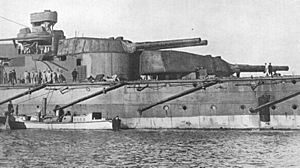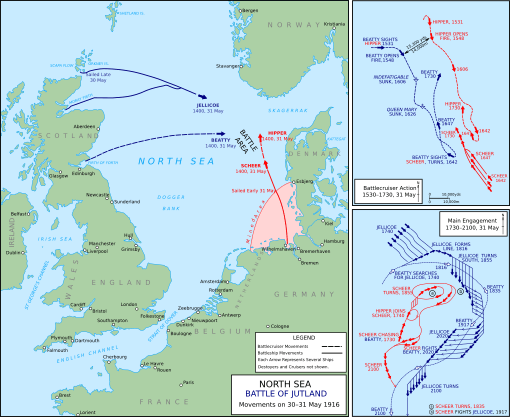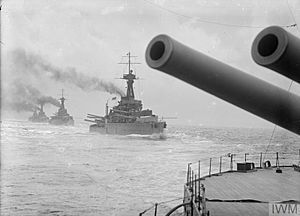HMS Thunderer (1911) facts for kids
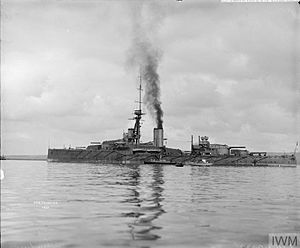
Thunderer at anchor, shortly after completion in 1912
|
|
Quick facts for kids History |
|
|---|---|
| Name | Thunderer |
| Ordered | 1909 |
| Builder | Thames Ironworks and Shipbuilding Company, Poplar, London |
| Laid down | 13 April 1910 |
| Launched | 1 February 1911 |
| Commissioned | 15 June 1912 |
| Decommissioned | 1921 |
| Reclassified | As cadet training ship, 1922 |
| Fate | Sold for scrap, 6 November 1926 |
| General characteristics (as built) | |
| Class and type | Orion-class dreadnought battleship |
| Displacement | 21,922 long tons (22,274 t) (normal) |
| Length | 581 ft (177.1 m) (o/a) |
| Beam | 88 ft 6 in (27.0 m) |
| Draught | 31 ft 3 in (9.5 m) |
| Installed power |
|
| Propulsion | 4 × shafts; 2 × steam turbine sets |
| Speed | 21 knots (39 km/h; 24 mph) |
| Range | 6,730 nmi (12,460 km; 7,740 mi) at 10 knots (19 km/h; 12 mph) |
| Complement | 738–1,107 (1917) |
| Armament |
|
| Armour |
|
HMS Thunderer was a powerful warship built for the Royal Navy in the early 1910s. She was the fourth and last ship of her type, known as the Orion-class class. These ships were called "dreadnought battleships" because they were very large and had many big guns.
Thunderer spent most of her time with the main British fleets, the Home and Grand Fleets. She took part in the famous Battle of Jutland in May 1916 during World War I. After the war, in 1921, she became a training ship for young naval students. Thunderer was sold for scrap in 1926. On her way to be taken apart, she got stuck in the mud but was later freed.
Contents
What was the Thunderer like?
The Orion-class ships, including Thunderer, were designed to be much bigger and stronger than earlier warships. They were built because Britain and Germany were in a race to build the most powerful navies. These ships were so advanced that they were sometimes called "super-dreadnoughts."
Thunderer was about 581 feet (177.1 m) long, which is longer than two football fields! She was 88 feet 6 inches (27.0 m) wide and sat 31 feet 3 inches (9.5 m) deep in the water. When fully loaded, she weighed about 27,416 long tons (27,856 t). In 1917, her crew had over 1,100 sailors and officers.
The ship was powered by two sets of steam turbines, which used steam from 18 large boilers. These engines gave her 27,000 shaft horsepower (20,000 kW) of power. This allowed Thunderer to reach speeds of about 21 knots (39 km/h; 24 mph) (around 24 miles per hour). She could travel about 6,730 nautical miles (12,460 km; 7,740 mi) (over 7,700 miles) at a slower speed of 10 knots (19 km/h; 12 mph).
How was Thunderer armed and protected?
The Orion-class ships had 10 huge 13.5-inch (343 mm) guns. These guns were placed in five turrets, with two guns in each turret. All five turrets were located along the center of the ship. This design allowed all the main guns to fire at the same target on either side of the ship.
For smaller targets, Thunderer had 16 smaller 4-inch (102 mm) guns. These were placed in single mounts around the ship's front and back sections. She also carried three torpedo tubes, which could launch torpedoes at enemy ships underwater.
To protect herself, Thunderer had a thick armoured belt along her side, up to 12-inch (305 mm) thick. Her decks were also armored, from 1 inch (25 mm) to 4 inches (102 mm) thick. The main gun turrets had 11 inches (279 mm) thick armor on their front.
What changes were made to Thunderer?
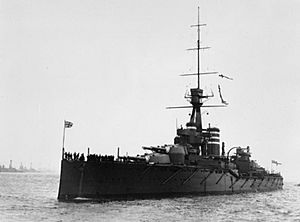
Over time, some changes were made to Thunderer. A special device called a fire-control director was added to help aim the guns better. In 1914, some of her smaller guns were put inside protected areas called casemates.
After the Battle of Jutland in 1916, more armor was added to her decks. Also, two of her four-inch guns were removed. Later, in 1917–1918, two platforms were added to the roofs of her 'B' and 'X' turrets. These platforms allowed small planes to take off from the ship.
Thunderer in Service
Thunderer was built by the Thames Ironworks and Shipbuilding Company in London. Her construction began on 13 April 1910, and she was launched on 1 February 1911. She officially joined the Royal Navy on 15 June 1912. Building her cost around £1.8 million, which was a huge amount of money back then!
Thunderer and her sister ships, Monarch and Orion, formed a group within the Home Fleet. They often took part in naval reviews and training exercises. In 1912, Thunderer was used in a special test to compare her new gun-aiming system with Orion's. Thunderer performed much better, showing how useful the new system was.
World War I Service
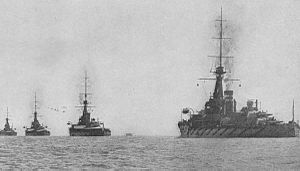
In July 1914, as tensions grew before World War I, Thunderer took part in a large fleet exercise. When the war began in August 1914, the Home Fleet became the Grand Fleet. This fleet was the main naval force of Britain.
Early in the war, the Grand Fleet moved to Scapa Flow for safety. However, concerns about German submarines led to the fleet being spread out. In October 1914, one of Thunderer's sister ships, Audacious, hit a German mine and sank. This made the navy even more careful about submarine threats.
Routine Patrols and Training
Throughout 1915 and early 1916, Thunderer and the Grand Fleet spent a lot of time doing gunnery drills and patrols in the North Sea. These patrols were often attempts to find and engage German ships, but most of the time, no major battles happened. The fleet would sweep through the North Sea, looking for enemy vessels, but often returned to port without seeing any.
Battle of Jutland
The Battle of Jutland was the largest naval battle of World War I. It happened on 31 May 1916. The German fleet tried to lure out and destroy part of the British Grand Fleet. However, the British knew about the German plan because they had intercepted and decoded German radio messages.
Thunderer, commanded by Captain James Fergusson, was part of the main British battle line. During the battle, she fired at a damaged German ship, the light cruiser SMS Wiesbaden. Later, she briefly fired at two German battleships. However, her view was often blocked by other ships. Thunderer fired only 37 of her large 13.5-inch shells during the entire battle.
After Jutland
After the Battle of Jutland, the Grand Fleet continued its patrols. In August 1916, the fleet tried to ambush the German fleet again, but miscommunications prevented a major battle. Due to the danger from German submarines and mines, the British decided not to risk their largest ships too far south in the North Sea.
In April 1918, the German fleet tried to attack British convoys (groups of ships traveling together). The British learned about this plan and sent the Grand Fleet to intercept, but the German ships turned back before they could be caught.
Thunderer was present at Rosyth, Scotland, on 21 November 1918, when the German High Seas Fleet surrendered. She remained part of the 2nd Battle Squadron until March 1919.
End of Service
By May 1919, Thunderer was moved to the 3rd Battle Squadron of the Home Fleet. In November, she was transferred to the Reserve Fleet at Portland. She was temporarily brought back into service in the summers of 1920 to transport troops to and from the Mediterranean Sea.
In February 1921, Thunderer began a new role as a training ship for young naval students at Rosyth. She started her first training cruise in June 1921. She served in this role until August 1926, when another ship took her place. Thunderer was then taken out of service.
On 6 November 1926, Thunderer was sold for scrap for £66,150. She was too deep to enter the scrapyard in Blyth. So, some parts were removed at Rosyth to make her lighter. Even then, she got stuck at the entrance to Blyth harbor on 24 December. After being freed, she went back to Rosyth to be made even lighter. Finally, on 12 April 1927, she was towed to Blyth and taken apart.
Images for kids


